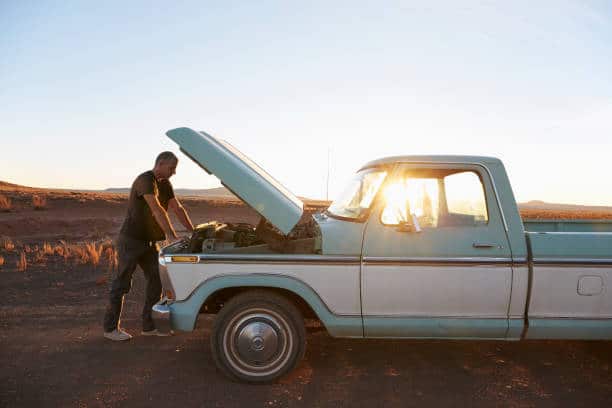Break Down in a Remote Area? What to do.
Stranded with a broken-down vehicle in the back of beyond, you’re not just inconvenienced; you’re potentially in a survival scenario. The key to handling this situation lies in preparation and knowing the exact steps to safeguard yourself and any passengers.
Key Takeaways:
- Stay Calm and Prepared: Keeping a cool head helps you make rational decisions.
- Visibility: Ensure your vehicle is visible to avoid further accidents.
- Communication is Key: Attempt to contact help even with limited signal.
- Have an Emergency Kit: Always keep essential supplies in your vehicle.

It’s a stark reality, finding yourself miles from civilization, with a sputtering engine as your only companion. Here’s a comprehensive guide to handling such daunting situations, ensuring you remain safe while help is on the way.
Securing Your Immediate Safety
Ensuring Your Vehicle Is Visible
Visibility can mean the difference between a speedy rescue and a long, risky wait. Immediately turn on your hazard lights. If it’s dark, keep your headlamps on if possible. This simple step alerts any passersby to your predicament, reducing the risk of collisions.
Strategically Use Safety Markers: If you have safety triangles or reflective markers, place them strategically around your vehicle. This is especially crucial if you’re around a curve or over a hill where oncoming traffic might not see you immediately.
How to Communicate in Low-Signal Areas
Finding yourself in a signal desert, where even one bar of cellular reception feels like a mirage, can be maddening. Here’s what you can do:
- Texts Over Calls: Text messages can often go through even with minimal signal.
- Use Emergency SOS Features: Many smartphones have an SOS feature that sends your location to emergency services and selected contacts.
Staying Safe While Waiting for Help
The Decision to Stay or Go
The age-old question: should you stay with your vehicle or try to find help on foot? Here’s the general rule—stay with your vehicle. It’s larger, more visible, and shelters you from elements. Only consider leaving if you know exactly where you are and have a clear destination in mind.

Handling the Arrival of a Tow Truck
When help arrives, ensure it’s the help you requested. Verify the identity of the tow truck driver by asking for identification or confirmation of the details you were given when you called for help.
Prepare Your Vehicle for Towing: Ensure that all personal belongings are secured before your vehicle is towed. Lock your car and hand over the keys to the tow operator only after verifying their credentials.
Practical Tips for Emergency Preparedness
Essential Items for Your Emergency Kit
Table: Recommended Items for a Roadside Emergency Kit
| Item | Purpose |
|---|---|
| Water and Snacks | Hydration and sustenance |
| First Aid Kit | Medical emergencies |
| Flashlight and Batteries | Visibility and signaling in the dark |
| Warm Blanket | Protection against cold |
| Flares or Reflective Triangles | Enhancing visibility |
Having these items readily available can dramatically improve your safety and comfort while waiting for assistance. Remember, the goal is to be prepared, not scared.
Managing Prolonged Wait Times
Keeping Morale High
Long wait times can test your patience and strain your mental health. Keeping a positive mindset is crucial. Engage in activities like listening to music, reading, or playing games on your phone to keep spirits high and anxiety at bay.
Monitoring Your Surroundings
Always be aware of your surroundings. Watch for any potential dangers like wildlife or changing weather conditions. Stay inside your vehicle as much as possible to protect yourself from external elements and maintain your energy levels.
Interacting with Emergency and Towing Services
When emergency vehicles or a tow truck arrive, knowing how to interact effectively can ensure your safety and smooth service.
Verify Before You Trust
Confirm the identity of any approaching help, especially in isolated areas. Ask for identification or a confirmation code that was given to you when you requested the service to avoid falling victim to scams.
Cooperation and Compliance
Once you’ve verified the tow truck operator or emergency responder, cooperate fully. Provide them with any necessary information about your vehicle’s condition and heed any safety instructions they give.
Frequently Asked Questions
What should I do if I’m running low on food and water?
Prioritize rationing any supplies you have. In emergencies, your vehicle’s location might take time to reach, so conserve resources wisely.
How can I signal for help if my phone dies?
Keep a portable charger in your emergency kit. If that’s not an option, use physical signals like flags or an SOS pattern with rocks or branches to increase your chances of being seen.
Is it safe to accept help from strangers in remote areas?
Exercise caution. If someone offers help, speak to them through a closed window and do not exit your vehicle until you’ve assessed their intentions. Trust your instincts.
What legal precautions should I take when my vehicle is towed?
Take photos of your vehicle before it’s towed and make sure to get a proper receipt and documentation from the towing company, detailing the condition of your vehicle and the terms of the towing.
Can I prepare my vehicle in any way to prevent breakdowns in remote areas?
Regular maintenance is key. Before a long trip, especially through remote areas, have your vehicle thoroughly checked by a professional to minimize the chances of a breakdown.
Continuing Your Journey Post-Tow
After your vehicle is towed, the next steps you take can significantly influence your onward journey. Ensure you communicate with your towing service about where your vehicle will be taken, understand the repair timeline, and arrange for alternate transportation if needed.
